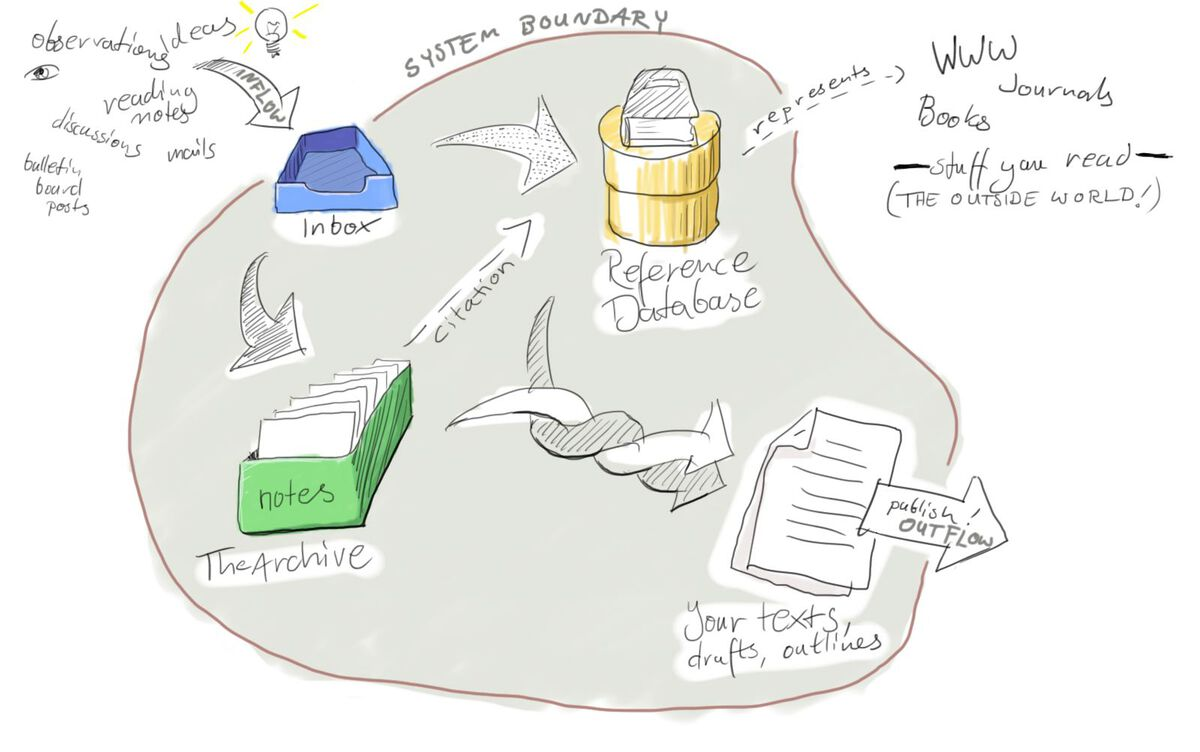Zettelkasten shouldn't be complicated, but it is.
Zettelkasten is Complicated
There are a lot of things I like about ZettelkastenZettelkastenThis is a unique note organization method that functions in a similar vein to a brain—through the connection of ideas. It is proven to promote learning and isn’t restricted by any hierarchical structure. As a result, note discovery is as simple as “following a train of thought”. Also see the two principles of zettelkasten, but one thing I don't like is how complicated it is to set up. According to the building blocks of Zettelkasten blog post, a typical Zettelkasten system consists of an inbox, an archive, and a reference database.
- Inbox: the gateway into your knowledge system (e.g. Google Notes, Email, Apple Notes, etc.)
- Archive: the one, trusted place to look for information (e.g. Obsidian, Roam Research, etc.)
- Reference Database: interface to the outside world (e.g. Raindrop, Zotero, etc.)
On top of a complicated setup, this tri-system approach adds limitations and friction when using Zettelkasten. For example, transferring notes from the inbox to the archive. This process is a requirement, not an optionthe illusion of choiceThe illusion of choice is a psychological mental model that states humans are happy if they believe that have control over their own actions and can exercise free will. https://www.joshuakennon.com/mental-model-the-illusion-of-choice/#:~:text=The%20illusion%20of%20choice%20is,and%20can%20exercise%20free%20will.. In other words, we'll need to regularly transfer items from my inbox to the archive. For some, this additional step is a deal-breaker. On the flip side, the option of writing directly to the note archive (skipping the inbox) typically adds additional frictionThe Totally Unnecessary Way To Write Quick Notes in ObsidianWriting Quick Notes in Obsidian When using Obsidian I know that having more connections is better. So I often take it upon myself to use Obsidian for everything. Thanks to the plugin system provided by Obsidian, it personalizes the way I use Obsidian and allowed me to do many things that would otherwise be impractical (e.g. getting my TODOs from Todoist). But even with this customizability, sometimes Obsidian just isn't the right tool for the job. One example is writing quick notes into Obsidia.

Finding a better solution
At its core, Zettelkasten can be distilled into two principlestwo principles of zettelkastenPrinciple of Atomicity**: Limit notes to a single topic for interoperability * See How to create useful links Principle of Connectivity**: Connect information together https://zettelkasten.de/posts/overview/#principles
- Principle of Atomicity: Limit notes to a single topic for interoperabilityinteroperable components are efficientBecause interoperabile components are self-contained, they can be reused in different situations and are easily maintainable (changing one, updates all). Related: notes/reuse code for efficiency and maintainability
- Principle of Connectivity: Connect information togetherconnecting ideas is powerful* encourages you to revisit old ideas and improves learning. * helps you discover new ideas through connections. * allows you to reuse your ideas in a different context. Related: notes/the brain is a network of ideas
As long as these two principles are maintained, our workflows can still be Zettelkasten. My approach to this problem is to create one system that combines the inbox, the archive, and the reference database into one system. Given that connectionsconnecting ideas is powerful* encourages you to revisit old ideas and improves learning. * helps you discover new ideas through connections. * allows you to reuse your ideas in a different context. Related: notes/the brain is a network of ideas are what make Zettelkasten powerful, having a single generalizeduse the right tool for the jobA one-size fits all solution is very broad and doesn't solve specific problems. Because the future is personalization, these one-sized fits all solutions don't help us very much. interconnected system is better than having three specialized systems (inbox, archive, reference database).
This single system needs to have certain criteria in order to perform well:
- Has the ability to take quick notes anywhere (inbox)
- Can easily reference the source of the material (reference database)
- Support backlinks and links with a search feature (the archive + principles)
This is why I created an application to simplify the typical Zettelkasten system. The goal of this application is to lower the barrier of entry for Zettelkasten and to help more people to be productive. If you're interested, read my blog post about my simple Zettelkasten workflowConfused On How To Manage Your Notes? Try This Simple Workflow.If you ever took notes on an article, video, or podcast and had no idea do with it, you're in the right place. Many existing solutions suggest adding tags, and creating many layers of nested folders. But oftentimes we find ourselves with folders with too many files or tags with too few members. The fault isn't in the person but in the note-taking system itself. My goal is to create a simple workflow where the content of the note organizes the note. This effectively eliminates the third step whe.
